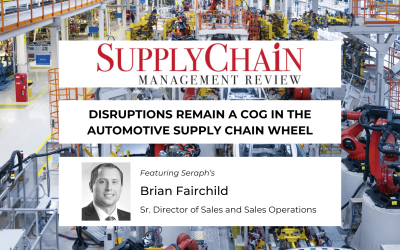SITUATION
Seraph was contacted by the OEM in the pre-production phase of the program launch to ensure the Supplier was properly planning for the complexity and variability of the OEM’s business model. The Supplier planning models were equipped for low variability production planning requirements. With a 6-hour time difference between the Supplier’s pre-assembly and final assembly plants, communication issues within plant cultures were evident. Seraph performed a GAP analysis which revealed three major areas of concern: internal material flows, ability of the Supplier to react to material fallout late in the manufacturing process or at the OEM, and overall readiness of the purchasing and planning systems.
APPROACH
Seraph analyzed the material flow within both of the Supplier’s plants to ensure that the proper amount of stock was in place and to identify any bottlenecks in the flow of materials. In turn, material storage was optimized to ensure ample space for storing the proper amount of material at every step of the manufacturing process for optimal pull-system performance.
Seraph ensured the Supplier’s ability to respond quickly to the material fallout late in the manufacturing process or at the OEM by creating a complexity matrix and value stream map. The Supplier was then able to visualize the number of Potential “Off-Lined” vehicles per month and the financial impact this would have to their organization. A short-term plan was developed to carry additional work in process (WIP) inventory at the final assembly plant, and a process was developed to replenish scrap and reject inventory rapidly. A long-term plan was also developed to relocate some manufacturing processes closer to the OEM’s location.
Our team reviewed and mapped the MRP / Materials processes and systems, which revealed that installed systems were not fully implemented throughout the business. Seraph found that the purchasing system was set-up to only import 2 weeks of customer demand; therefore, changes in the release would not be identified in time to adjust orders to long-lead, time-mandated suppliers.
Additionally, the system did not account for scrap throughout the manufacturing process, which led to material shortages and numerous expedites.
Seraph found that the Bill of Material in the purchasing system was manually maintained by the buyers, but was not part of the formal Engineering Change Process.
Finally, Seraph found that the Bill of Material in the purchasing system was manually maintained by the buyers, but was not part of the formal Engineering Change Process. Our team worked with the Supplier’s Corporate Logistics and IT departments to implement changes that closed these gaps and developed processes that aligned the purchasing system with the OEM’s expectations.
RESULTS
While at the Supplier’s plants, Seraph implemented countermeasures to protect the OEM against supply interruptions by increasing WIP inventory at the final-assembly plant, optimizing assembly kitting process, modifying the purchasing system to incorporate 9-month forecast from the OEM, and providing additional training to all Buyer’s on the purchasing system. Run-out reports were developed for the Buyer to proactively view potential material shortages.
In order to improve communication between the OEM and Supplier for longer lead-time action plans, several Work Packages were developed by Seraph. The Work Packages focused on capacity constraints, material flow and inventory accuracy improvement, purchasing system development, and engineering change management. The Supplier assigned champions to monitor and track KPI performance to the agreed upon targets with the OEM.





